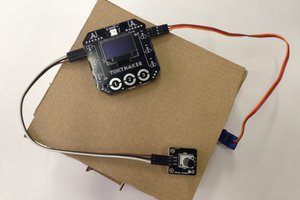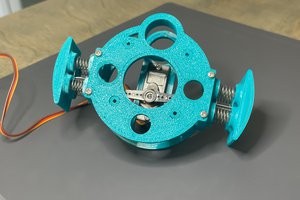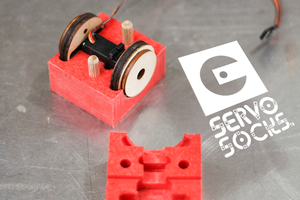My project’s function is to allow for easy watering of a plant and to rotate the
plant when light levels are high to avoid uneven growth. The sensors and
actuators are a DC submersible pump, a continuous servo, a photoresistor,
and a button. If the button is pressed, the pump will turn on (pumping water
through a tube) and the continuous servo will spin, allowing for easy and
uniform watering. If the light levels are above a certain threshold, the servo
will rotate regardless of whether or not the button is pressed. Finally, if the
button is not pressed and light levels are low, the system will remain
stationary.
What I would do differently if I started again:
If I were to start this project again, I would get a larger turntable and get a
better method to keep the rubber band on the shaft of the servo. The larger
turntable would allow for larger plants to be compatible with the system and
a better pulley or wheel would make it harder for the rubber band to slip off
of the servo. Overall, the project went extremely well and the same
components could all be used to achieve the same result reliably and
effectively.
What would I change with more money and time:
With fewer constraints, I would make a more robust “base” to hold the
continuous servo and plant, buy a larger servo, and buy a much larger
turntable. The more robust base would allow for the servo to be screwed
into the base for a firmer connection while the larger turntable and servo
would allow for the system to be used with a larger plant. In essence, a
bigger, more solidly built system would do a better job of providing useful
watering and plant rotation.
How to Assemble:
1. Assemble the circuit as shown in appendix B
2. Cut a hole in the 5" x 7" x 1/16" piece of cardboard as shown in
appendix C. Make sure to leave the hole small enough to be a press fit
for the servo. The tight fit is what allows the servo to not rotate when
the rubber band is later attached.
3. Press the servo into the hole.
4. Glue the turntable onto the cardboard so that the center of the servo
shaft and the center of the turntable are 6 inches apart
5. Stretch a rubber band around the servo shaft and the turntable to
allow the servo to spin the turntable.
6. Place the pump in a reservoir of water close enough to the turntable
so that the tubing can reach the plant.
7. Upload the code to the Arduino
8. Turn on the system and enjoy!
Operation Instructions:
1. Make sure that the reservoir is full of water (make sure the DC pump
intake is below the water surface).
2. Ensure that the photoresistor is not covered or in the shadow of
anything.
3. Place a plant on the center of the turntable. Remember that it will spin
on its own when it is light, so you need to have the load centered.
4. Press the button to rotate the plant and pump water through the tube
for easy watering. Watch your plant revolve when ambient light levels
are high.
For more information on the BOM, look at the files attached to this project.


 TokyLabs
TokyLabs
 Smalls
Smalls
 Dan Kitchen
Dan Kitchen